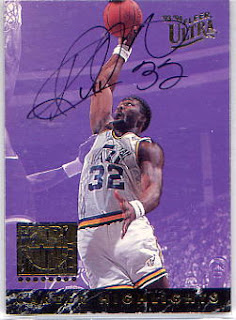
He added 15 points In the Bruins semifinal win over Oklahoma St.
He scored 24 in UCLA’s 2nd round thrilling win over Missouri. He averaged over 19 a game in the NCAAs.
In the regular season O’Bannon was one of the nation top players and was award Player of the Year by the U.S Basketball Writers and the Wooden award and was a consensus All-American.
He was the co-Pac-10 player of the year.
Ed averaged 20.8 points, 8.3 rebounds, 1.9 steals (team high), 53% fgs and 43% 3FG (55-127).
UCLA finished the season on a 19 game winning streak. In the non conference UCLA beat #2 Kentucky. They finished 32-1 and 17-1 in the Pac-10 and earned the #1 seed in the West and finished on top of the AP poll.
In the NCAA tournament, they handled #18 Mississippi St. in the sweet 16, escaped #8 UConn 102-96 to get to the Final Four. They beat #14 Oklahoma St. 74-61 and Arkansas 89-78 to win the title.
The Bruins averaged over 87 points per game, good for 8th in the country.
2. Corliss Williamson: Was the NCAA tournament’s leading scorer with 125 points scored.
He was named All-Final Four, and was the Midwest region MVP
In the sweet 16 vs  Memphis St. Big Nasty poured in 27 and 13 in Arkansas’ 96 91 overtime victory.
Memphis St. Big Nasty poured in 27 and 13 in Arkansas’ 96 91 overtime victory.
Wiliamson helped the Hogs get back to the Final Four with 21 points, eight reb. and three ast in a hard fought 68-61 win the regional final over #13 Virginia.
In the Final Four vs. #4 North Carolina Williamson had 19 of his 21 points in the second half to propel Arkansas to the title game 75-68.
He was the SEC Player of the Year for the second straight year, and consensus 2nd team All-Ameican, as well as All-SEC tournament.
He put up 19.7 points, 7.5 rebs., and shot 55% from the field.
Arkansas finished #6 in the final poll and a #2 seed in the NCAAs. They finished the season 32-7 and 12-4 in the SEC (West champions) and lost to #2 Kentucky (95-93, OT) in the SEC title game. They lost to #1 UCLA in the national title game.
3. Jerry Stackhouse: Was named Player of the Year by Sports Illustrated and considered one of the top all around players in the country by his peers.
He was the Southeast region MVP, and capped that performance of with 18 points 12 rebounds and six assists in a 74-61 regional final win over top seed Kentucky.
He had 18 points in the Final Four loss to Arkansas.
He was a consensus All-American and All-ACC.
Stackhouse led the Tar Heels with 19.2 points, 8.2 rebounds and 50 steals. He chipped in with 2.7 ast per contest and 51% FGs, including 41% on 3s.
His most memorable play was this dunk in UNC’s double overtime win over rival Duke.
North Carolina was co-regular season ACC champion at 12-4 and 28-6 overall. The Tar Heels were a season low #4 in the final polls and were #1 six weeks. They advanced to the final four and lost to #6 Arkansas, after defeating #2 Kentucky and #22 Georgetown in the regionals.
















